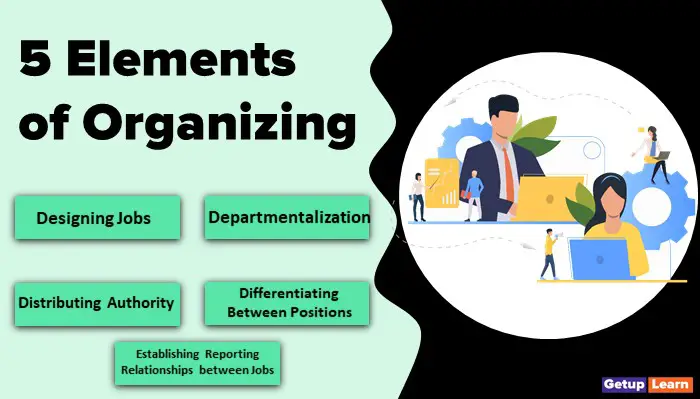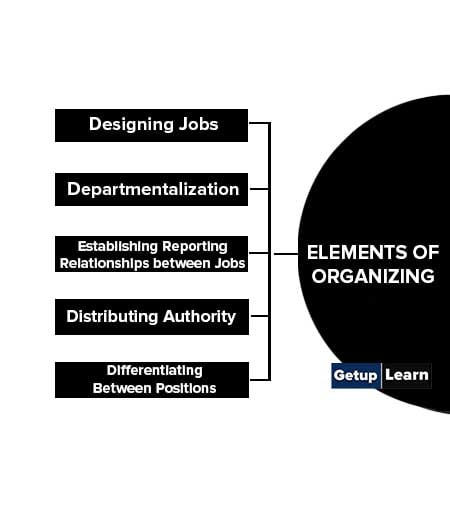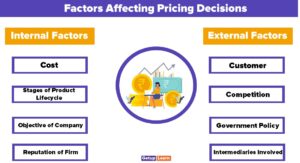
Table of Contents
Elements of Organizing in Management
The organizational structure shows the corporate communication, and the executive and managerial hierarchy, and creates a plan for efficient growth in the future.
For managers, organizing is deciding how best to group organizational elements for a variety of structural possibilities. Managers must understand the best combination for the organization’s structure.
There are six basic building blocks that managers can use in constructing an organization which are also known as elements of organizing or organizational structure:
- Designing Jobs
- Departmentalization
- Establishing Reporting Relationships between Jobs
- Distributing Authority
- Differentiating Between Positions

Designing Jobs
Job design is the first building block of organizational Structure. It means defining an individual’s responsibilities at work. Job design involves defining areas of decision-making responsibility, identifying goals and expectations, and establishing appropriate indicators of success. There are many tools available to a manager for designing jobs:
- Job Specialization
- Job Characteristics Model (JCM)
- Work Teams
- Job Rotation
- Job Enlargement
- Job Enrichment
Departmentalization
Departmentalization is a grouping of jobs according to some logical arrangement, the second building block of organization structure.
Departmentalisation refers to the formal structure of the organization, composed of various departments and managerial positions and their relationships with each other. As an organization grows, its departments grow and more sub-units are created, which in turn add more levels of management.
This often creates less flexibility, adaptability, and units of action within the firm. Departmentalisation is the efficient and effective grouping of jobs into meaningful work units to coordinate numerous jobs-all for the expeditious accomplishment of the organization’s objectives.
Types of departmentalization in management:
- Functional Departmentalization
- Product Departmentalization
- Customer Departmentalization
- Departmentalization by Process
- Departmentalization by Task Force
- Location or Territory Departmentalization
- Matrix Departmentalization
Establishing Reporting Relationships between Jobs
The establishment of reporting relationships among positions is the third basic element of organizing. The establishment of reporting relationships indicates; clarifying the chain of command and the span of management.
The chain of command shows a clear distinct line of author among the positions and the span of management indicates the number of people who report to a particular manager. Here; the organization’s hierarchy, its positions, and lines are defined.
Distributing Authority is another important building block in structuring organizations. Authority in the organization is the right in a position and, through it, the right of the person occupying the position to exercise discretion in making decisions affecting others.
Authority is the power that has been legitimized by the organization. Here; the determination of how authority is to be distributed among positions. Distributing authority in the organization means; giving decision power to employees.
A warehouse manager must have the authority to check the quality of the material coming and storing, to record the events in the storage, to check and report on the quantity of material, and much more. But he cannot make a decision on deciding the selling price for them.
That’s why the proper distribution of authority throughout the organization is required for the smooth sailing of the organization. Two specific issues that managers must address when distributing authority are delegation and decentralization.
Differentiating Between Positions
Differentiating between line and staff positions in the organization is the last building block of the organization structure. A line position is in the direct chain of command also responsible for the achievement of an organization’s goal.
On the contrary; a staff position is there only to provide expert advice, and support for line positions. However; in modern organizations, these differences are very less; in some cases, the difference is eliminated.
Organizational structure is the formal pattern of interactions and coordination designed by management to link the tasks of individuals and groups in achieving organizational goals.
Objectives of Organizing
The objectives of organizing can vary depending on the specific context, but some common goals include:
- Increased Efficiency
- Improved Productivity
- Reduced Stress
- Enhanced Functionality
- Greater Accountability
- Better Decision-Making

Increased Efficiency
Having a well-organized space and systems can help you save time and energy by having everything in its designated place and being able to find things more easily. For example, if you have a designated place for your keys, you won’t have to spend time searching for them when you need to leave the house.
Improved Productivity
A cluttered workspace can be distracting and make it difficult to focus on tasks. By getting organized, you can create a space that is conducive to productivity, allowing you to stay focused and get more done.
Reduced Stress
Disorganization and clutter can contribute to feelings of stress and overwhelm. By getting organized, you can create a calm and peaceful environment that reduces these negative feelings.
Enhanced Functionality
Organizing can help you make the most of your space and resources, allowing you to use them more effectively and efficiently. For example, if you organize your kitchen, you will be able to access cooking tools and ingredients more easily, making meal prep more efficient.
Greater Accountability
Organizing can also help with accountability, as it allows you to keep track of your possessions and responsibilities more easily. For example, if you have a designated place for important documents, you will be less likely to lose them or forget about them.
Better Decision-Making
A clear and organized space can help you think more clearly and make better decisions. When you are surrounded by clutter and disorganization, it can be difficult to focus and think critically. By getting organized, you can create a space that supports clear and focused thinking.
What are the elements of organizing?
These are the elements of organizing in management:
1. Designing Jobs
2. Departmentalization
3. Establishing Reporting Relationships between Jobs
4. Distributing Authority
5. Differentiating Between Positions.
What are the basic elements of organizing?
The following are the basic elements of organizing:
1. Setting Goals
2. Evaluating Current Systems
3. Creating a Plan
4. Implementing the Plan
5. Maintaining Organization
6. Being Flexible.
What are the objectives of organizing?
The following are the objectives of organizing:
1. Increased Efficiency
2. Improved Productivity
3. Reduced Stress
4. Enhanced Functionality
5. Greater Accountability
6. Better Decision-Making.













